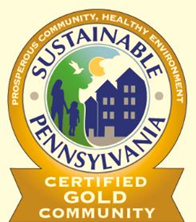Sustainable Pennsylvania Certified Gold Community

Ferguson Township is proud to be recognized as a Certified Gold Community by Sustainable Pennsylvania. The certification is offered by The Pennsylvania Municipal League in cooperation with Sustainable Pittsburgh, and allows local governments to showcase their progress toward sustainability initiatives that improve organizational efficiency and effectiveness.
To attain the certification, the Township has completed an online assessment that evaluates the municipality in areas of Governance and Community Engagement; Healthy Communities; Diversity, Equity, and Inclusion; Education; Energy Use, Conservation, and Green Building; Environmental Stewardship; Housing; Land Use and Transportation; and Other Sustainability Innovation. The level of certification attained depends on the number of "Yes" responses the municipality provides and the number of supporting web links that verify the "Yes" answers.
On this page, you'll find the items on the sustainability assessment that the Township is advancing either on the local level, or in partnership with the Centre Region Council of Governments. You will also find links to the documents that were used to substantiate those items. You may also view the complete submission on the Sustainable Pennsylvania website.
Governance and Community Engagement
Municipal Operations
1a. Professional staff are employed or retained, in the areas of budgeting and finance.
1b. A revenue-expenditure trend analysis is conducted annually.
1c. Funds for capital-related borrowing are not used for day to day expenses.
1f. 5-10 percent of operating funds are carried over year to year.
Community Engagement
2a. Civic engagement, public participation and transparency are regularly assessed and facilitated,
Local and Regional Cooperation
3a. Municipality is an active participant in a Council of Governments.
3c. Intergovernmental Cooperative Agreements include conflict resolution provisions.
Sustainability
4c. Sustainability policies, goals, and principles have been adopted.
Public Safety
Healthy Communities
Local Food
6a. Incentives exist for establishment of farms and gardens within the municipality.
6d. A community produce garden(s) is available.
Healthy People
7b. Outdoor recreation opportunities, amenities, and lifestyles are promoted.
Diversity, Equity, and Inclusion
Human Resources
8c. The municipality has provided diversity training for municipal employees.
Economy
9a. There is a municipal policy ensuring Minority Business Enterprise and Women Business Enterprise are considered in municipal purchasing, bids and contracts.
Education
Cooperation
Engagement
Energy Use, Conservation, and Green Building
Municipal Energy Use
12a. Municipality has or is in the process of retrofitting street lights and traffic signals to LED bulbs.
Community Energy Use
13a. The municipal comprehensive plan contains an energy conservation element.
Green Buildings
Environmental Stewardship
Water Use, Conservation, and Quality
16c. Low impact development and onsite stormwater infiltration is encouraged.
16d. Water provider(s) prioritize improving service to existing developed areas as opposed to opening up new areas to development.
16e. Drinking water and sanitary sewer rates are based on the real cost of providing service.
Air Quality
17a. PA State anti-idling law is enforced and compliance is promoted.
Green Infrastructure
18a. Policies, plans and ordinances protect wetlands and waterways and their buffers.
18f. Sustainable landscape maintenance practices are in place for parks and municipal grounds.
Housing
Affordability
19b. The comprehensive plan addresses the community benefits of and need for expanding housing choice.
19c. The zoning ordinance has inclusionary housing provisions/incentives.
Sustainable Neighborhoods
20a. A current inventory of vacant and blighted/blighting properties is maintained and mapped.
20e. Staffing is in place sufficient to enforce building and maintenance codes.
Land Use and Transportation
Mobility
21a. Trails for walking and bicycling are being developed or maintained.
21e. Police are trained on the rights and responsibilities of bicyclists and state law on passing bicycles.
Community
22a. Professional staff are employed or retained to manage the land use program.
22c. A multi-municipal comprehensive plan has been adopted as has an official map.
Green Space
23d. The greenspace/open space plan has benchmarks and results are reported annually to the public.
23e. The municipality has a PA Dept of Agriculture Agricultural Security Area (ASA).
Thriving Local Green Business
Material Use, Waste, and Recycling
25b. There is a curbside and/or drop-off recycling program.
25e. There is an active public informational program to encourage citizens to reduce waste and recycle.
25f. All municipal buildings have an active recycling program.
25i. Municipality has an active litter prevention/clean-up program.

